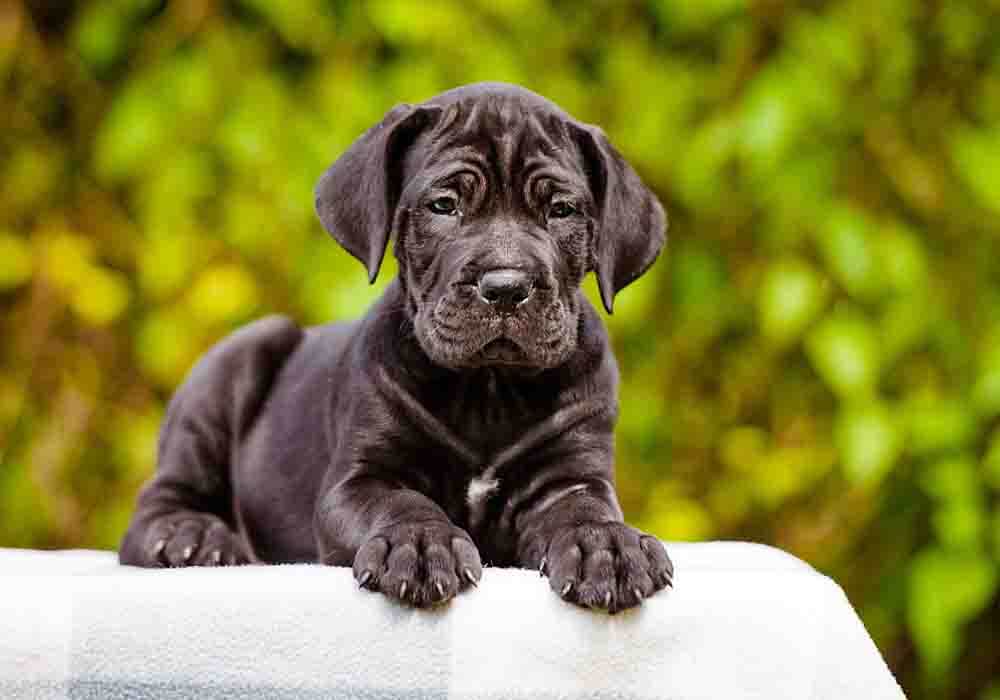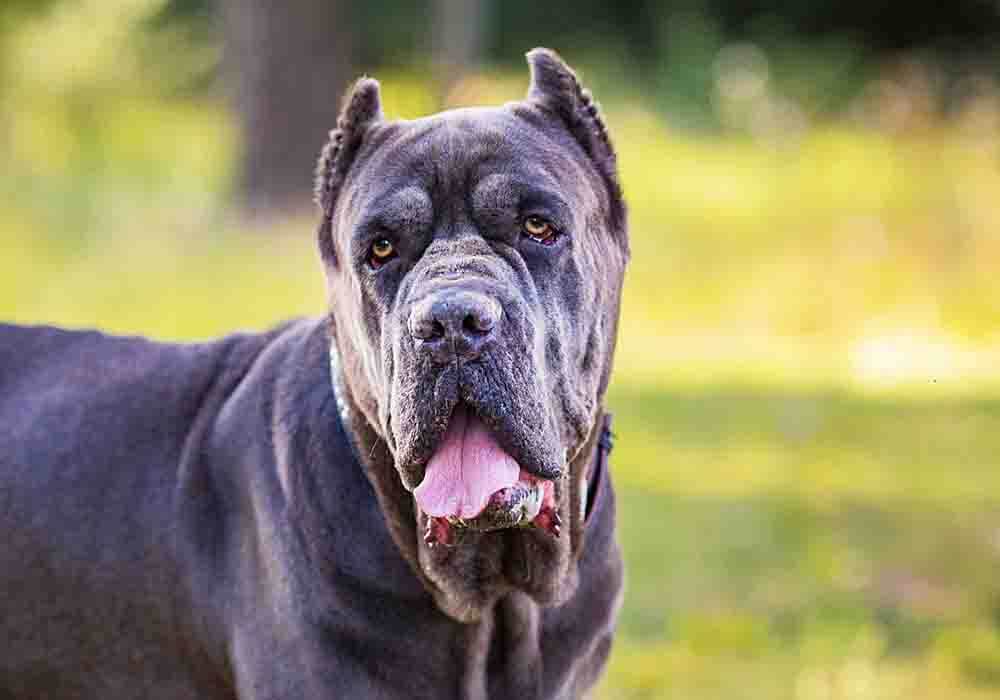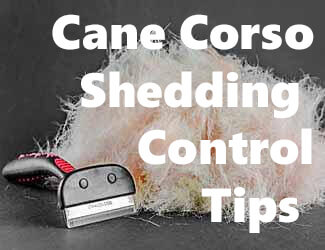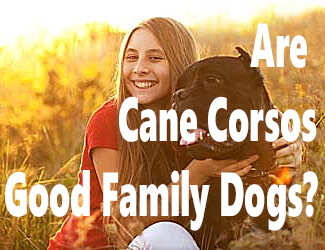Everything I Need To Know
About Cane Corso
34 Interesting Fun Facts About This Breed
by Ken Alden
We wrote this Everything I Need To Know About Cane Corso page because there was...well...so many fascinating things about this dog! It's amazing history, size and good looks just add to the allure of this amazing breed.
The Cane Corso breed has a lineage that reaches back to Roman times. These dogs are the 32nd most popular breed in America and usually weigh more than 100 lbs. They are easily identified by their muscular build, shiny short-haired coat, and wide head. Cane Corsos are affectionate and intelligent.
If you’re looking into the Cane Corso breed, you likely have a lot of questions. These dogs are in the top 30 of the American Kennel Club’s ranks, but not a lot about them is common knowledge. In the following article, we’ll answer almost every question you might have about this majestic breed thru these most commonly asked questions. Read More Below...
Pro-tip: Ever try lifting a Cane Corso? Their weight can hurt not only your back but their joints when they hop down from cars, sofas or even your bed. To protect your back and theirs check out the best Mastiff ramps on Amazon.com now.

Are Cane Corso Good Guard Dogs?
Cane Corsos make excellent guard dogs. They were historically used as guard dogs throughout Italy, after their origins from Ancient Rome. What makes these canines such a good guard dog is their intelligence, their powerful stance, and their fierce loyalty to their owners.
Are Cane Corsos Easy to Train?
These dogs are highly intelligent, which doesn’t always make for the most obedient dog. Cane Corsos can be trained, but it usually takes someone with a firm hand to do so. These pups are so smart that they might challenge you on the commands you give them. The key to successfully train a Corso is to start young, and above all, be consistent.
Are Cane Corsos Naturally Protective?
After decades of being used as guard dogs, this breed has a
natural affinity for being
protective. They have a great
sense of threat and won’t shy away from a fight. Most Corsos shouldn’t be left
in a yard unattended; just in case something or someone happens to walk by that
they don’t like. This is important to consider when it comes to everything I need to know about Cane Corso
Can a Cane Corso Kill a Human?
Cane Corsos can, and have, killed humans. In an infamous case from 2014, two loose Cane Corsos in Michigan attacked and killed a jogger running near their property. The owners of the animals were charged with second-degree murder, and the canines were euthanized.
It’s crucial to train your Corso properly and to invest in a
professional dog behaviorist if you see any signs of aggression in your dog.
Can Cane Corso Be Left Alone?
Cane Corsos can be left alone for short periods, but they are prone to destructive boredom. If you’re going to leave your Cane Corso alone outside, make sure you have a secure fence of at least six feet in height. A Corso could easily jump over or get his head above a shorter fence and bite a passerby.
Before leaving your Corso alone, you should always exercise your dog to tire him out and do some training or games for mental stimulation, too. This will keep him calmer while he’s alone and lower the chance of him getting destructive.
Pro-tip: Cane Corso anxiety, aggression, destructive chewing, jumping up, fearfulness, and other behaviors can be controlled with the right training program.
Here’s a great course that
addresses these issues along with many other dog training basics: Check it out now!
Can Cane Corso Live Outside in Winter or Summer?
When answering everything I need to know about Cane Corso we'd be remiss if we didn't answer whether they can or can't handle heat or cold. Depending on where you live, these dogs can live outside year-round. Somewhere with severe winters like Minnesota would not be a good place to have a Corso live outside in the winter, but a warmer state, like Florida, could probably house a Corso outside year-round. Most areas of the United States would be suitable for a Corso to live outside during the summer.
Any dog who lives outside should still be provided with proper
safety, shelter, and companionship. everything I need to know about cane corso
We've got a whole article dedicated to the Canes tolerance to heat and cold, be sure to check it out here.
Do Cane Corso Have Health Issues?
Cane Corsos, like other large breeds, are prone to a few main health issues. Hip dysplasia is a hereditary disease that causes arthritis in many large dogs. Bloat, or Gastric Dilation Volvulus, is an often deadly condition that involves the twisting of the stomach and digestive tract.
The best way to defend against these issues is through proper
diet and feeding practices, and by requesting genetic testing for your future
puppy.
Do Cane Corso Have Webbed Feet?
While all dogs have slightly webbed feet, Cane Corsos do not have overly webbed feet, unlike Labrador Retrievers. Corsos aren’t particularly fond of water and weren’t bred to have webbed feet for swimming or digging.
Do Cane Corsos Jump Fences?
Cane Corsos may not look like big jumpers at first, but their back legs are so powerful that they have been known to jump fences as high as six feet. Just watch this 65kg Cane Corso effortlessly jump onto a tall cement wall:
Do Cane Corsos Make Good Pets?
If you’re searching for a fierce companion that will intimidate neighbors and protect your family, while being gentle enough to cuddle on your couch, a Corso will make an excellent pet for you. If, however, you’re more interested in owning an easy-going dog that won’t challenge your training, then this breed won’t make a good pet.
Here's an article of ours for those that might be considering one as a family pet.
We go over all the pro's and con's of this amazing dog from a family angle.
Do Cane Corsos Shed a Lot?
Cane Corsos are a short-haired breed that does shed a fair amount. They will shed often, and this can be minimized by daily brushing in an outdoor area. This breed is not a good option for those who have dog allergies, as their fur will be everywhere.
How Long Do Cane Corso Dogs Live?
The life span for Cane Corsos is between 8 and 12 years. The median lifespan for males is 9.25 years, and for females, it is 9.33 years.
How Much Will My Cane Corso Weigh?
Most dogs in the breed weigh between 90-120lbs, but this can vary depending on genetics and gender. Males will weigh around 110lbs, and females will weigh around 100lbs.
How Smart Are Cane Corsos?
Cane
Corsos have average breed intelligence. They aren’t whip-smart
like Border Collies, but they can learn commands quicker than Basset Hound.
Are Cane Corso Good for First Time Owners?
When asking everything I need to know about Cane Corso it's important to know that these dogs are not a good breed for first-time owners. They are often stubborn and can challenge a trainer with low authority. Because a Cane Corso can grow to develop aggression and be a real threat to humans, it’s important that only an experienced dog owner and handler choose this breed.

Here's a greater in depth article on whether Cane Corsos are a good choice for first time owners...it's a must read
What Are Cane Corso Used For?
These dogs have been used for guarding people and properties for centuries. They are very alert watchdogs, have an intimidating bark, and a keen ear for intruders.
Cane Corsos were also used to help hunt big game, like boars and bears, but as these hunts declined, they were adopted by the Italian farmers. Many Corsos still work on these farms up to this day. everything I need to know about cane corso

So what were Cane Corsos bred for? This fascinating article of ours plumbs the historical depths to reveal this dogs original reason for being bred.
What Do Cane Corso Eat?
Since Cane Corsos are so large and have a high amount of muscle, it’s important to feed your dog a diet rich in protein and carbohydrates. The carbs will serve to provide your dog with energy, while the protein will provide building blocks for his muscles. If you feed your pet kibble, he will likely eat between 5-8 cups of food a day. Half this if mixing with wet food, and talk to your vet when considering a raw food diet.
What Does Cane Corso Mean in Italian?
The name Cane Corso comes from a combination of Latin and Italian. “Cane” means “dog” in Latin, while “Corso” may have originated from the Italian “Corsus,” which means “robust” or “sturdy.” So the name Cane Corso generally means “sturdy dog” in Italian.
When Will My Cane Corso Calm Down?
With dogs, the larger the breed, the longer it takes them to mature fully. Cane Corsos tend to take 2.5 to 3 years to fully mature physically, and their energy levels usually won’t begin to settle until then, either. A Cane Corso will be high energy for most of his life, but you can expect the first three or four years to be the most full-on.
When Will My Corso Stop Growing?
As mentioned, Cane Corsos reach full physical maturity by the
age of three. They will likely
reach full height by a year but will
continue to grow muscle and bone mass for the next year and a half. By three
years, your Corso will be as big as he is going to get.
Want to see just how fast they grow? This article of ours gives the month by month staggering growth of this dog...it's amazing!
Where Do Cane Corsos Originate From?
The ancestors of Cane Corsos lived on the islands of Greece, being raised by the Molossi Tribes. When the Romans invaded Greece, they brought these ancient dogs back with them, known as “Molossers.” From these Molossers, the Romans bred two types of dogs, Cane Corsos and the even larger Neopolitan Mastiff.
The Romans used Cane Corsos to charge alongside them in battle.
The dogs are said to have charged enemies with flaming oil containers strapped
to the canine’s sides. Romans also bred the dogs for fighting in the arenas,
which included battling against other massive dogs, and even lions.
Why Are Cane Corsos Banned in Different Countries?
Many countries ban breeds that they deem “dangerous.” Because of the potential harm that
powerful breeds such as Mastiffs, Corsos, Dogos, and Pit Bulls can inflict,
they are often included in this list. It’s not so much that these dogs are
inherently violent, but when they are not properly cared for and trained, the
potential for damage is much higher than with a small dog.
Pro-tip: Cane Corso's (and their owners) love dog crates…and for good
reasons. Crates keep dogs from mischief while you're away, are perfect for house
training, for traveling by car, and provide the dog a place to de-stress. Check
out the best Mastiff crates on Amazon.com now.
Why Are Cane Corso So Expensive?
The average price for Cane Corsos in America is $1,100 US. This makes them a big investment for someone shopping for a dog. However, a dog is an emotional investment anyways, so if you’re not prepared to meet the costs, then you may not be ready for a pet.
Corsos, in particular, need genetic testing to help defend the breeder’s line from hereditary diseases. Puppies also need sets of shots and vaccinations to send them out into the world safely. Some breeders also crop the dog’s ears, dock their tails, and charge more for these procedures. Cane Corsos are also growing in popularity, and so breeders are finding that they can charge more for this noble dog.
Why Do Cane Corsos Drool?
Cane
Corsos have a large upper lip, or “flews” as they are
also called. When a dog has large or floppy upper lips, their saliva is not
properly contained within their mouth. This allows the slobber to escape and results
in a puddle of drool at their feet.
Why Do They Crop Cane Corso Ears?
Cane Corsos are born with floppy ears, but most are cropped when young. There are a few reasons to crop a Cane Corso’s ears. The first is that the Corso is a dog used for defense. When a dog fights another dog or even a human, their ears could be bitten and grabbed during a fight. Not only will this cause profuse bleeding, but it will serve as their own body being used against them.
Another reason we crop any dogs’ ears is that in nature, most animals have upright ears. If you think of a wolf, fox, coyote, hyena, lion, or lynx, you’ll note that all of these animals have open, upright ears. This allows these animals to hear better and hunt better, but it also reduces the chance of infection.
Ears that are open are allowed to breathe and dry out after they’ve gotten wet. It was when humans started domesticating dogs that their ears became floppy.
Cropping your Cane Corso’s ears will allow the inner ear to
breathe, letting the body push out dirt and the flesh to dry out. Damp ear
canals covered by a floppy ear can cause a host of painful infections.

There's much more to read on the subject of Cane Corso ear cropping and tail docking. So we've dedicated this article in order to cover it in greater depth.
Why Do They Cut Cane Corso Tails?
Tail
docking is another procedure that has a function, though this one is not
as relevant today as ear cropping. A working dog with a long tail is at higher
risk of their tail being stepped on and injured by one of the herds it is
tending. The tails were docked for years to remove this risk, and became part
of the AKC breed standard, and is mostly continued
today for aesthetics. everything I need to know about cane corso
Why Does My Cane Corso Lean on Me?
It
was once hypothesized that dogs lean on their
owners to show dominance, but this has since been disbanded. It’s more likely
that dogs lean on you to show a level of comfort and contentment with your
presence. Your Corso might want attention, a meal, or even playtime, but that
does not mean to pick a fight with you.
Why Does My Cane Corso Shed So Much?
Cane Corsos shed daily, and usually an average amount. If you find that your four-legged friend is shedding more than normal, it’s probably due to the time of year. Corsos can develop a thick undercoat in colder climates, and come springtime, will shed this coat like it’s going out of style.
Why Is My Cane Corso Drooling So Much?
These dogs are typically highly food motivated, compare that with their loose upper lip, and you have a walking puddle factory.
Why Is My Cane Corso Puppy So Lazy?
Cane Corso puppies are usually very energetic. If your puppy is lazy for a day, it might be because it is rainy outside, or he is busy growing. However, if your young dog is lazy for multiple days in a row, you should consult with your vet, especially if his appetite is low.
Why Is My Cane Corso Scared of Everything?
The number one reason why any dog, including Cane Corsos, are scared of anything is that they weren’t properly socialized as puppies.
Within the first month of your puppy being home, you should aim
to have him meet 100 people. You should also have him meet dozens of dogs and
take him to every type of situation and setting that you can think of. If you
adopt an older dog, work with a trainer to identify his fear triggers, and
remedy them.

There's a lot of reasons Canes (or any dogs) can be scared of anything. This article explains this in greater depth and offers solutions to help.
Will a Cane Corso Attack an Intruder?
While it’s not guaranteed that an untrained Cane Corso will attack an intruder, it could happen. What’s almost guaranteed is that your dog will attempt to ward the intruder off with his mighty bark. If you want your dog to attack an intruder, you need to go through professional training with him to develop that skill safely.
Will a Cane Corso Turn On Its Owner?
When it comes to everything I need to know about Cane Corso you should ask this question...will my dog turn on me?
If you’ve raised your Corso from a puppy and you’ve socialized it well, given its firm but loving training, then there is no reason to fear that it will turn on you. However, if you’ve just adopted a Corso with mysteries in its past, then it’s best to be on your guard for the first year of the dog being in your home.
While most dogs want to please their owners, you won’t know everything that has happened in that pup’s past, and what random things might trigger aggressive behavior.
Will My Cane Corsos Eyes Stay Blue?
Some puppies of this breed are born with piercing blue eyes. Unfortunately, this is a temporary feature, as the eyes will darken within a few months.
Everything I Need To Know About Cane Corso...Final Thoughts
Cane Corsos are a regal, loyal breed that makes a fantastic guard dog. If you want a dog that will protect your property during the day but sit lovingly next to you by the fireplace at night, then the Corso could be the perfect pet for you.
Back To The TOP Of This Everything I Need To Know About
Cane Corso Page

About the Author...
Ken Alden, a dedicated Mastiff owner for over eight years, is acclaimed for his expertise in care, grooming, and training. Read more About Me and my dog Shadow.
- Mastiff Guide Home ›
- Cane Corsos ›
- Everything I Need To Know About Cane Corso









